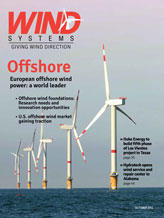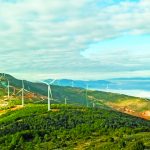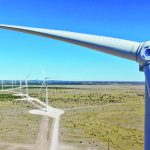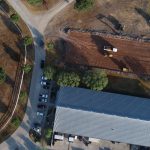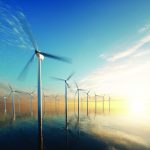“The U.S. offshore wind industry should adopt transformative design solutions for fixed foundations that build infrastructure resilience to domestic hazards, such as hurricanes, while minimizing the manufacturing, deployment and operational cost.”
This was the overarching theme that emerged from a recent workshop on Research Priorities for Offshore Wind Foundations, sponsored by the Georgia Tech Strategic Energy Institute May 22, 2014 in Atlanta, Georgia. The goal of the workshop was to promote discussion and develop consensus between academia, industry and funding agencies on two basic questions: are international standards appropriate for the design of offshore wind fixed foundations in the U.S., and if not, what are the research and development initiatives that, if pursued in this realm, can have significant impact on the growth of the domestic offshore wind industry?
Despite the diversity of expertise and interests reflected in the presentations, invited participants, representing industry, academia, and funding organizations from the United States, the United Kingdom, Germany, and Denmark, unanimously recognized that although regulations are in place for the first generation of U.S. offshore wind farms, novel design concepts targeting cost reduction are necessary to establish offshore wind as a competitive resource in the U.S. energy market. To that end, advancing our technical understanding in the realm of seabed-foundation interaction, and accordingly refining design regulations, is an important step.
The need for design refinements can be traced back to the fundamental goal of design standards, which is to ensure that resistance is larger than the applied loads. The offshore wind industry, however, whose towers differ substantially from oil platforms in terms of loads and resistance, has adopted foundation design protocols of oil and gas installations but has selectively addressed only some of the characteristic differences of the two industries, and what’s more, has done so independently of each other. This has led to offshore wind foundation standards that lack an overall design philosophy, and have large built-in uncertainties in the characterization of loads and resistance — wind speed, wave height, wave kinematics and slam forces, steel and soil stiffness and strength, and soil-foundation interaction — uncertainties that are, in fact, disproportionately larger than the narrow window of performance requirements of offshore wind installations.
One could argue here that uncertainties notwithstanding, these standards have been successfully implemented and tested by the wind industry in Europe for 20 years. Still, long-term data on the performance of Europe’s offshore wind installations is lacking. European installations are also founded on shallower waters and often-stiffer soils, and are not designed to withstand the impulsive gusts, and breaking and slamming wave forces, characteristic of U.S. hurricanes. At the same time, the opportunities to learn from failure case studies of operating wind farms in Europe are limited, since such data are almost always proprietary. Still, published data from experimental farms have shown significant variation in the design and performance of installed towers. For example, in 1994, when one of two instrumented turbines of the offshore farm Lely in the Netherlands showed 35 percent error in the estimated eigenfrequencies compared to measurements, the source of error was traced back to code deficiencies in soil characterization and in foundation design. Although standards have advanced since, not least because of the experience gained through instrumentation of offshore installations, regulations that have so far worked in Europe are not guaranteed to work for the site conditions and environmental loading of U.S. installations.
When asked to identify pressing needs in research and development, the workshop participants identified challenges relating to the foundation geometry: offshore wind foundation dimensions exceed the experience range of the oil and gas industry, and extrapolating current practice to larger sizes could introduce unintended effects. Unresolved issues were also identified in the realm of resistance to serviceability loads: the behavior and possible degradation of soil strength under millions of cycles of combined dynamic loading from the wind turbine and waves is not well described in the current standards. How does the soil-foundation-tower system behave when subjected to millions of loading cycles? Does it stabilize or fail, and what are the parameters that determine the performance regime in each case? The issue of extreme load characterization was also prominently featured: extreme loads from breaking waves are shown to frequently drive the overall design, and should thus be explicitly accounted for in U.S. design standards through appropriate load factors for severity and recurrence, equivalent to the design standards of API in the Gulf of Mexico. Lastly, research needs in site characterization were identified, calling for standardized procedures that will enable spatial variability of soil properties to be quantified and accounted for in design.
The list of research needs and priorities serves as a reminder that as the industry evolves, greater efforts should be prioritized to refine foundation design models for U.S. offshore wind installations. Addressing the challenges identified through systematic and constructive research will improve characterization of loading and resistance uncertainties, which will, in turn, enable the industry to develop performance standards focused on reducing the associated risk. Although these efforts will help building infrastructure resilience, however, they will not alone reduce cost drastically enough to impact the competitiveness of offshore wind in the U.S. energy market. Drastic cost reduction will likely require a paradigm shift in the logistics of U.S. offshore wind, from one-off fabrication to high volume manufacturing procedures, which include high volume chains, standardized on-site manufacturing, availability of jack-ups and installation vessels, along with the associated changes in harbor capacities. As engineers, we tend to rely heavily on established standards. To that end, the most important take-home message of the workshop was that in the realm of offshore wind foundations, diverging from the status quo and the path of regulatory least resistance, and supporting research, experiments and pilots while moving forward with deployment, can help develop a new path forward for the industry.
This article summarizes the collective thoughts of a large group of individuals: Domniki Asimaki and Kevin Haas from Georgia Tech, organizers of the workshop; Giovanna Biscontin from the University of Cambridge, Cambridge, United Kingdom; Brent Cooper from Ocean and Coastal Consultants, Charleston, South Carolina; Dan Dolan from MMI Engineering; Will Hobbs from Southern Company, Atlanta, Georgia; Kerstin Lesny from University of Duisburg-Essen, Germany; Torben Lorentzen from FORCE Technology, Copenhagen, Denmark; to Mary Hallisey Hunt from Georgia Tech; Ralph Nichols from the Savannah River National Laboratory; Daniel O’Connell from the Bureau of Ocean Energy Management, Brian O’Hara from the Southeastern Coastal Wind Coalition, Raleigh-Durham, North Carolina; and Glenn Rix, Geosyntec Consultants. Support for the workshop was provided by the Georgia Tech Strategic Energy Institute; the organizers are very grateful for the leadership of the institute’s director Timothy Lieuwen and for the funding opportunity that made this workshop possible.
— Source: EDF EN Canada
















